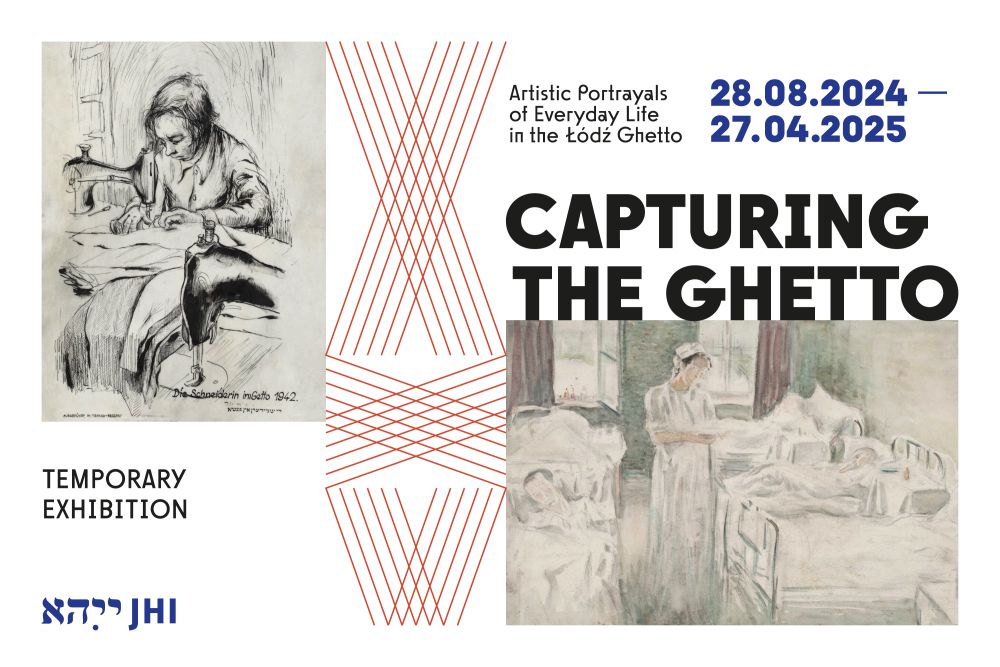- News
- Events
- Oneg Shabbat
- Collections
- Research
- Exhibitions
- Education
- Publishing Department
- Genealogy
- About the Institute
- Bookstore

.jpg)
This exhibition accompanies the 80th anniversary of the liquidation of the ghetto in occupied Łódź.
The Łódź ghetto existed from February 8, 1940, to August 29, 1944. During this period, over 200,000 people passed through it – both Jews from Łódź and nearby towns, as well as those deported from the Third Reich or the Protectorate of Bohemia and Moravia. Jews were forcibly settled in an area of only 4,13 km2. About 45,000 people in the ghetto died from hunger and disease. Most of the inhabitants were murdered in the extermination camps in Chełmno nad Nerem and Auschwitz-Birkenau. It is estimated that no more than 12,000 people survived the war.
The exhibition presents various aspects of the extremely difficult life of Jews in the ‘closed district’ created by the Germans. Overcrowding, terrible sanitary conditions and food shortages affected everyone, although not equally. The ghetto survived for so long because its inhabitants undertook the production of various goods for the German economy. Showing that the ghetto was working and that the German economy needed its inhabitants was the most important goal of the Jewish administration, led by Chaim Mordechaj Rumkowski. Traces of this policy are visible in many of the works that make up the exhibition.
The everyday life of the ghetto was shown using the collections of the Jewish Historical Institute: original paintings and drawings created in the ghetto – primarily by Józef Kowner, Izrael Lejzerowicz and Icchok Brauner – as well as objects made in the ghetto using various techniques. Some of them are inspired by observations of everyday life and are fully elaborated works. Others seem more like a record of reality or reportage. Still others were commissioned by the Jewish administration and they aimed to convince the Germans of the usefulness of the work of the Jews of Łódź; they are an expression of false hope for salvation.
The exhibits, accompanied by curatorial commentary and basic facts, including biographical information about the creators of these works, present the everyday life of the ghetto and the circumstances in which they were made. The content and meaning contained in them, as well as their artistic form, become understandable. Of particular importance are those works that artists made out of an internal need to document the realities experienced by thousands of Jews. They are an expression of resistance to the borderline situation in which their creators found themselves, an attempt to save life and preserve humanity.
THE EXHIBITION IS EXTENDED UNTIL APRIL 24, 2025.
Accompanying events (in Polish): https://www.jhi.pl/artykuly/uchwycic-getto-wydarzenia-towarzyszace,7892
Tickets: https://tickets.jhi.pl/
Opening hours: https://www.jhi.pl/en/plan-your-visit
Exhibition curators
dr Jakub Bendkowski, dr Zofia Trębacz
Content supervision
dr Ewa Wiatr
Design project
Łukasz Izert
Exhibition production
Marta Kapełuś
English translation
Natalia Kłopotek, Zofia Sochańska
Editing
Jolanta Rudzińska
Proofreading
Marcin Romanowski, Zofia Sochańska
Conservation
Violetta Bachur, Maciej Stasiewicz
Communication and marketing
Anna Dobrowolska-Balcerzak, Aleksandra Galant, Natasza Majewska, Dominika Wiśniewska
Acknowledgements
Michał Trębacz, Zuzanna Schnepf-Kołacz, Monika Taras, Irmina Gadowska, William Gilcher, Zuzanna Benesz-Goldfinger, Marta Kapełuś, Michał Krasicki, Anna Ekielska, Agnieszka Reszka, Marzena Mikos, Adam Sitarek
![Uchwycić getto - Kolofon.png [88.71 KB]](https://www.jhi.pl/storage/image/core_files/2024/8/27/b9dec9e3b63405e7f825d7005bfacab2/png/jhi/preview/Uchwycić%20getto%20-%20Kolofon.png)